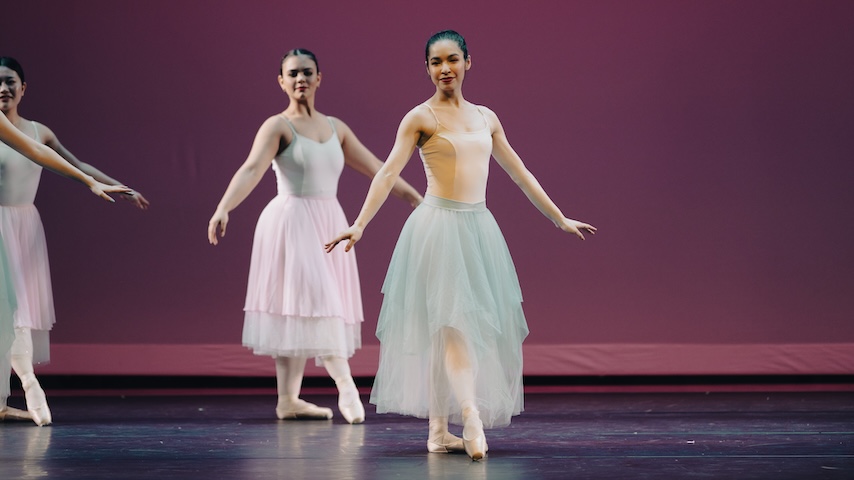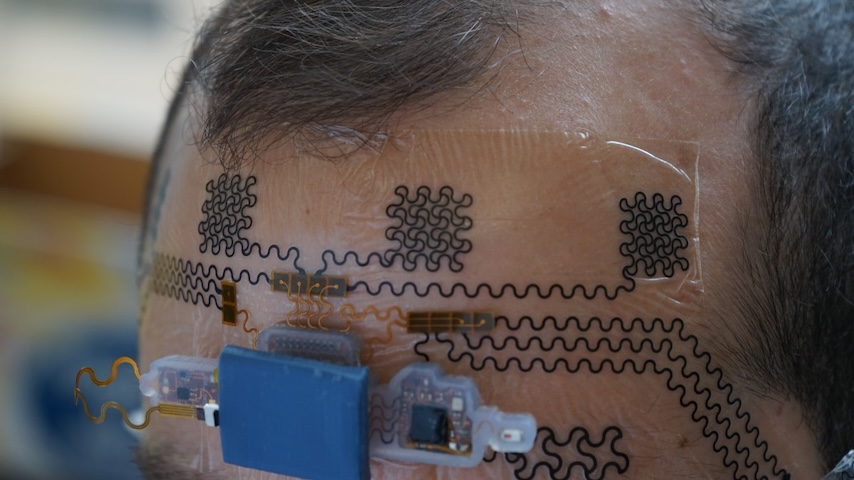Engineering Meets Art to Achieve the Perfect Pointe
Engineering Meets Art to Achieve the Perfect Pointe


A new device aims to keep dancers aligned and injury-free while dancing en pointe.
Pointe shoes are something of an engineering marvel all on their own. Paste, cardboard, and fabric combine to make a structure that not only supports the weight of a dancer but does so in a streamlined and efficient package, leaving very little room to spare. But when it comes to learning how to dance in these shoes, in addition to proper form and technique, alignment is everything. It takes years of training to properly use pointe shoes, but a new device aims to lend a technological assist to that process.
A team of students at Johns Hopkins University’s Whiting School of Engineering has developed a solution called PointeSense, which is a smart toe pad and ankle band system designed to help prevent injuries by ensuring that dancers are achieving the ever-elusive perfect alignment.
Christine Fernandez, a biomedical engineering major, and Kaitlyn Kumar, a master’s student in robotics, are both ballet dancers and co-invented PointeSense along with biomedical engineering master’s students Daniel Campuzano and Bryan Sabogal.
“I had one idea based on my experience as a dancer,” Fernandez recalled. “Kaitlyn had injured herself in the spring [during a performance en pointe], so she was still recovering from that injury. And she had talked about how the cool if we could have technology that would help with that recovery process.”
But when dancing, it can be difficult to determine whether both feet are aligned properly—if not, the resulting injuries can be serious.
Listen to the Podcast: Engineering Better Pointework
“We did our first project in that class and then in the spring, my group and I continued into a more intensive design process where we were continuing to work on that project,” Fernandez continued. At that point, Kumar joined the team, “since it was partially inspired by her experiences,” she added.
The result is a smart toe pad, basically a half sock that wraps around the toes equipped with sensors that fits within the very few millimeters of space between the foot and the toe box. An ankle band that attaches to the toe pad provides the dancer with haptic feedback to guide them toward proper alignment when necessary.
“It’s essentially a very smart toe pad telling you what is going on in the shoe. It’s not doing anything to your toes. It’s just giving you a very good mapping of what is happening,” Kumar explained.
“For now, what we came to was haptics—one of the easiest things to implement is vibration. We embedded these tiny little vibration motors around the ankle so you can get directional vibration feedback to try to guide you,” she said.
Discover the Benefits of ASME Membership
As for the toe pad, the team first used two off-the-shelf flex sensors, one on the top of the foot and the other on the bottom. They were able to drastically improve the sensor set up with the help of doctoral student Arik Slepyan, who has been working on force pressure sensor matrices, Fernandez explained.
Currently, the toe pad features 64 sensors that are the same thickness and flexibility as a piece of paper.
Fernandez and Kumar are now working on the second iteration of their prototype.
“The thing with working on technology that needs to fit on a dancer is we have to make everything untethered and everything as small as possible. And that in itself gets pretty complicated,” Kumar said. “The whole part that we’re still trying to figure out is alignment detection. Right now, we have a pretty small sample size in terms of data. We really need to get ourselves to a point where we can do more robust testing so we can collect data from a variety of different people and populations to train a better algorithm.”
“In terms of the commercial market, there isn’t something that does everything we’re doing,” Kumar added. “We’re essentially taking bits and pieces of things that exist in products or in research and packaging it all together and making essentially a completely new application.”
Since news broke of the innovation, the team has fielded numerous calls from across the sports world asking about the technology.
“It could be for rock climbing, it could be for football—there are a lot of sports that have foot injuries out there,” she added. “At least from a hardware perspective, it’s definitely something in the back of our minds. We’re doing this with a focus on dance, but with a swap of a sensor, maybe this could work for something else.”
In addition to looking at what scaling costs might be, next steps will involve collecting as much information as possible from dance schools, as well as freelance, amateur, and professional dancers, Fernandez said.
“We just had a wonderful meeting with some of the teachers at the Peabody Preparatory in Baltimore about if they were going to use this device in their classrooms, teaching their students, what would they need it to do? How would they need it to work for them so that we are making sure we’re producing a product that’s actually useful to the different populations who would use it,” Fernandez said.
Although dance and engineering appear to be very disparate worlds with little to no overlap, Kumar emphasized that it’s always possible to find connections.
Fernandez agreed: “Anybody who has disparate interests, don't be scared to try to combine them and don’t feel like it’s forbidden because it’s not. And it can be really beautiful when you do.”
Louise Poirier is senior editor.
A team of students at Johns Hopkins University’s Whiting School of Engineering has developed a solution called PointeSense, which is a smart toe pad and ankle band system designed to help prevent injuries by ensuring that dancers are achieving the ever-elusive perfect alignment.
Christine Fernandez, a biomedical engineering major, and Kaitlyn Kumar, a master’s student in robotics, are both ballet dancers and co-invented PointeSense along with biomedical engineering master’s students Daniel Campuzano and Bryan Sabogal.
First steps
During the fall 2024 semester, Fernandez was taking a Principles of Design of Biomedical Instrumentation/Honors Instrumentation course sequence during which the students had to develop a prototype biomedical device.“I had one idea based on my experience as a dancer,” Fernandez recalled. “Kaitlyn had injured herself in the spring [during a performance en pointe], so she was still recovering from that injury. And she had talked about how the cool if we could have technology that would help with that recovery process.”
But when dancing, it can be difficult to determine whether both feet are aligned properly—if not, the resulting injuries can be serious.
Listen to the Podcast: Engineering Better Pointework
“We did our first project in that class and then in the spring, my group and I continued into a more intensive design process where we were continuing to work on that project,” Fernandez continued. At that point, Kumar joined the team, “since it was partially inspired by her experiences,” she added.
The result is a smart toe pad, basically a half sock that wraps around the toes equipped with sensors that fits within the very few millimeters of space between the foot and the toe box. An ankle band that attaches to the toe pad provides the dancer with haptic feedback to guide them toward proper alignment when necessary.
“It’s essentially a very smart toe pad telling you what is going on in the shoe. It’s not doing anything to your toes. It’s just giving you a very good mapping of what is happening,” Kumar explained.
Fine tuning
But should the toe pad data indicate misalignment, the question then became how could the user be informed—it’s something the team is still iterating on, Kumar continued.“For now, what we came to was haptics—one of the easiest things to implement is vibration. We embedded these tiny little vibration motors around the ankle so you can get directional vibration feedback to try to guide you,” she said.
Discover the Benefits of ASME Membership
As for the toe pad, the team first used two off-the-shelf flex sensors, one on the top of the foot and the other on the bottom. They were able to drastically improve the sensor set up with the help of doctoral student Arik Slepyan, who has been working on force pressure sensor matrices, Fernandez explained.
Currently, the toe pad features 64 sensors that are the same thickness and flexibility as a piece of paper.
Fernandez and Kumar are now working on the second iteration of their prototype.
“The thing with working on technology that needs to fit on a dancer is we have to make everything untethered and everything as small as possible. And that in itself gets pretty complicated,” Kumar said. “The whole part that we’re still trying to figure out is alignment detection. Right now, we have a pretty small sample size in terms of data. We really need to get ourselves to a point where we can do more robust testing so we can collect data from a variety of different people and populations to train a better algorithm.”
Next steps
With so many variables when it comes to feet and shoes, even just for a single person, many more hurdles remain in creating a device that could be used somewhat universally. To ensure the right path forward, Fernandez and Kumar are working with physical therapists and experts in dance medicine to learn more about the actual biomechanics of the foot and ankle, how injury happens, and precisely what and how the device should be correcting an end user.“In terms of the commercial market, there isn’t something that does everything we’re doing,” Kumar added. “We’re essentially taking bits and pieces of things that exist in products or in research and packaging it all together and making essentially a completely new application.”
Since news broke of the innovation, the team has fielded numerous calls from across the sports world asking about the technology.
“It could be for rock climbing, it could be for football—there are a lot of sports that have foot injuries out there,” she added. “At least from a hardware perspective, it’s definitely something in the back of our minds. We’re doing this with a focus on dance, but with a swap of a sensor, maybe this could work for something else.”
In addition to looking at what scaling costs might be, next steps will involve collecting as much information as possible from dance schools, as well as freelance, amateur, and professional dancers, Fernandez said.
“We just had a wonderful meeting with some of the teachers at the Peabody Preparatory in Baltimore about if they were going to use this device in their classrooms, teaching their students, what would they need it to do? How would they need it to work for them so that we are making sure we’re producing a product that’s actually useful to the different populations who would use it,” Fernandez said.
Although dance and engineering appear to be very disparate worlds with little to no overlap, Kumar emphasized that it’s always possible to find connections.
Fernandez agreed: “Anybody who has disparate interests, don't be scared to try to combine them and don’t feel like it’s forbidden because it’s not. And it can be really beautiful when you do.”
Louise Poirier is senior editor.








